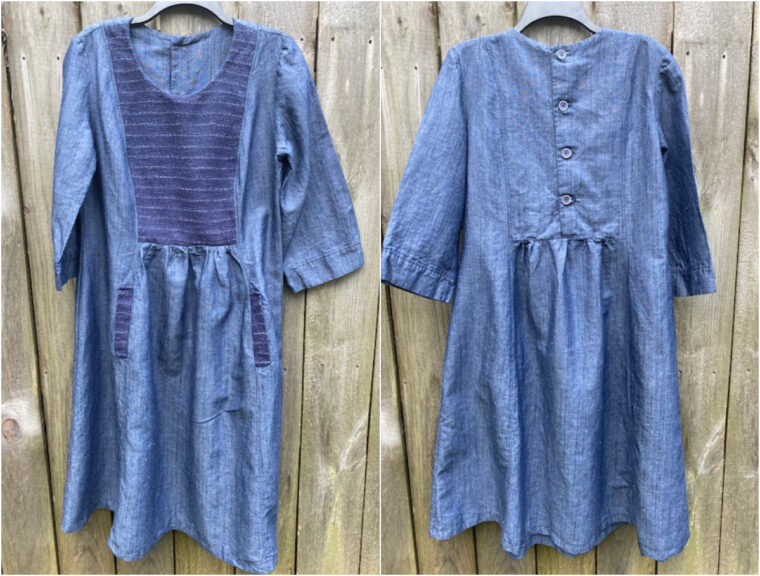For years I’ve been dreaming of owning a rigid-heddle loom and in 2020 I finally broke down and bought one. After weaving scarves, dishcloths and napkins, I realized that, if I was going to do this weaving thing, I was going to have to figure out how to mesh it with my love of garment sewing.
My loom width is only 24â€, which limits the size of pattern pieces I can make. But after looking through some different versions of the Cinema Dress pattern, I loved the idea of using a different fabric for the yoke. I was overjoyed when I
found that the yoke pattern piece was a perfect width for my loom!

Next came the process of choosing yarn for the woven yoke, and finding fabric for the rest of the dress. I decided on a lovely dark indigo chambray. I knew that I wanted the yoke to stand out a little bit, but not too much. And to keep the yoke piece from being too thick, I needed to use a thinner yarn.
I started out trying a linen/cotton blend yarn by Gist Yarn in a dark indigo and light blue for both the warp and weft. I struggled with the tension on two attempts (I am a new weaver after all). I found success on my third try, using a dark indigo cotton for the warp and saving the linen/cotton blend for the weft.

The scariest part of this whole process was cutting into my handwoven fabric. After gathering my courage to cut out the front yoke piece, I found I had enough for the welt pocket pieces, too.

I will be honest that this pattern can feel a little overwhelming as you get started. There are lots of pattern pieces and since this is a longer dress, they are large pattern pieces. But as with all Liesl + Co. patterns, the pattern directions are simple and clear and if you take your time, everything comes together easily. The pattern comes with instructions for altering the bust area, but fortunately I didn’t need to make these alterations.
I cut out a size 10 and did not need to make any alterations. Design-wise, I opted for a shorter skirt piece, and I didn’t topstitch the yoke. I did not put the v-notch into the neckline as the patter suggests, and left the neckline rounded instead. I knew that the thickness of the handwoven fabric might make it difficult for the notched neckline to lay nicely.

There are a few things I would do differently when sewing this pattern again. I’ve started finishing my seams with my serger prior to piecing them together, but for this pattern, I didn’t do it. This wasn’t really a major deal until I got to the side panels and the pockets. I wish that I had finished the edges of all four pocket pieces and the side panels prior to stitching them together. It was super-hard to do this after I had sewn them all and I don’t have the clean finish on the inside that I would have if I had serged them first.
(Speaking of sergers, I’ve recently started using my serger to gather my fabric and man, what a different it makes. I did that for the skirt pieces and the sleeves and I’m so crazy happy with how it turned out, compared to when I try to gather with basting stitches. If you have a serger, I highly encourage you to figure out the settings for your machine and give it a whirl!)

I will say that this dress at times reminds me of something out of the 1700s (maybe I’ve been watching too much Outlander), but it also sort of screams “homeschool mom†(which I actually am). I knew when I chose the chambray it was risky, but overall I am happy with how this dress turned out. Every time I look at the front yoke piece I’m so excited (and sort of in awe, honestly) that I made that fabric. I haven’t made a dress like this for a really long time and it’s so lovely to put it on and give a twirl.
(adsbygoogle = window.adsbygoogle || []).push({}); Â
Regular Low Denier Polyester Yarn
300D Polyster Yarn,420D Polyester Yarn,250D Ht Polyester Yarn,150D Ht Polyester Yarn
ZHEJIANG GUXIANDAO POLYESTER DOPE DYED YARN CO., LTD , https://www.htpolyesteryarn.com